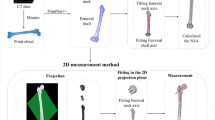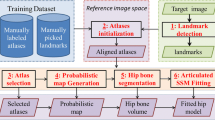Abstract
Clinically, Taylor spatial frame (TSF) is usually used to correct femoral deformity. The first step in correction is to analyze skeletal deformities and measure the center of rotation of angulation (CORA). Since the above work needs to be done manually, the doctor’s workload is heavy. Therefore, an automatic femoral deformity analysis system was proposed. Firstly, the Hough forest and constrained local models were trained on the femur image set. Then, the position and size of the femur in the X-ray image were detected by the trained Hough forest. Furthermore, the position and size were served as the initial values of the trained constrained local models to fit the femoral contour. Finally, the anatomical axis line of the proximal femur and the anatomical axis line of the distal femur could be drawn according to the fitting results. According to these lines, CORA can be found. Compared with manual measurement by doctors, the average error of the hip joint orientation line was 1.7°, the standard deviation was 1.75, the average error of the anatomic axis line of the proximal femur was 2.9°, and the standard deviation was 3.57. The automatic femoral deformity analysis system meets the accuracy requirements of orthopedics and can significantly reduce the workload of doctors.






Similar content being viewed by others
Availability of Data and Material
Not applicable.
Code Availability
Not applicable.
References
Taylor JC: Perioperative Planning for Two- and Three-Plane Deformities. Foot and Ankle Clinics 13:69-121, 2008
Ganger R, Radler C, Speigner B, Grill F: Correction of post-traumatic lower limb deformities using the Taylor spatial frame. Int Orthop 34:723-730, 2009
Dammerer D, Kirschbichler K, Donnan L, Kaufmann G, Krismer M, Biedermann R: Clinical value of the Taylor Spatial Frame: a comparison with the Ilizarov and Orthofix fixators. J Child Orthop 5:343-349, 2011
Mohammed, Zhana Fidakar; Abdulla, Alan Anwer (2020). An efficient CAD system for ALL cell identification from microscopic blood images. Multimedia Tools and Applications, (), –. https://doi.org/10.1007/s11042-020-10066-6
Abdulla A A . Efficient computer-aided diagnosis technique for leukaemia cancer detection. 2020. IET Image Process., 2020, Vol. 14 Iss. 17, pp. 4435–4440
Zhang, X., Sun, H., Chen, J. et al. Optimization of electronic prescription for parallel external fixator based on genetic algorithm. Int J CARS 14, 861–871 (2019). https://doi.org/10.1007/s11548-019-01931-3
Gall J, Lempitsky V: Class-specific Hough forests for object detection. 2009 IEEE Conference on Computer Vision and Pattern Recognition:1022–1029. https://doi.org/10.1109/cvpr.2009.5206740, 2009
Cristinacce D, Cootes T: Automatic feature localisation with constrained local models. Pattern Recognition 41:3054-3067, 2008
Breiman L: Random Forests. Machine Learning 45:5-32, 2001
Fanelli G, Yao A, Noel P-L, Gall J, Van Gool L: Hough Forest-Based Facial Expression Recognition from Video Sequences. ECCV 2010:195-206, 2012. https://doi.org/10.1007/978-3-642-35749-7_15
Cootes TF, Taylor CJ: Combining point distribution models with shape models based on finite element analysis. Image and Vision Computing 13:403-409, 1995
Cootes TF, Taylor CJ, Cooper DH, Graham J: Active Shape Models-Their Training and Application. Computer Vision and Image Understanding 61:38-59, 1995
Cootes TF, Wheeler GV, Walker KN, Taylor CJ: View-based active appearance models. Image and Vision Computing 20:657-664, 2002
Burges CJC: A Tutorial on Support Vector Machines for Pattern Recognition. Data Mining and Knowledge Discovery 2:121-167, 1998
Xie W, et al.: Statistical model-based segmentation of the proximal femur in digital antero-posterior (AP) pelvic radiographs. Int J Comput Assist Radiol Surg 9:165-176, 2013
Zheng G, von Recum J, Nolte LP, Grützner PA, Steppacher SD, Franke J: Validation of a statistical shape model-based 2D/3D reconstruction method for determination of cup orientation after THA. Int J Comput Assist Radiol Surg 7:225-231, 2011
Cristinacce D, Cootes TF: Facial feature detection and tracking with automatic template selection. 7th International Conference on Automatic Face and Gesture Recognition (FGR06):429–434. https://doi.org/10.1109/FGR.2006.50, 2006
Lindner C, Thiagarajah S, Wilkinson J, Consortium T, Wallis G, Cootes T: Fully Automatic Segmentation of the Proximal Femur Using Random Forest Regression Voting. IEEE Trans Med Imaging 32:1462-1472, 2013
Lindner C, Bromiley PA, Ionita MC, Cootes TF: Robust and Accurate Shape Model Matching Using Random Forest Regression-Voting. IEEE Transactions on Pattern Analysis and Machine Intelligence 37:1862-1874, 2015
Paley D: Principles of Deformity Correction, 1st edn, Berlin, Heidelberg: Springer Berlin Heidelberg, 2002
Martins P, Caseiro R, Henriques JF, Batista J: Discriminative Bayesian Active Shape Models. ECCV 2012:57-70, 2012
Wright D, Whyne C, Hardisty M, Kreder HJ, Lubovsky O: Functional and Anatomic Orientation of the Femoral Head. Clinical Orthopaedics and Related Research® 469:2583–2589, 2011
Cherian JJ, Kapadia BH, Banerjee S, Jauregui JJ, Issa K, Mont MA: Mechanical, Anatomical, and Kinematic Axis in TKA: Concepts and Practical Applications. Curr Rev Musculoskelet Med 7:89-95, 2014
Yang G, Jiang Y, Liu T, Zhao X, Chang X and Qiu Z (2020) A Semi-automatic Diagnosis of Hip Dysplasia on X-Ray Films. Front. Mol. Biosci. 7:613878. https://doi.org/10.3389/fmolb.2020.613878
Hussain, Dildar; Al-antari, A. Mugahed; Al-masni, A. Mohammed; Han, Seung-Moo; Kim, Tae-Seong (2018). Femur segmentation in DXA imaging using a machine learning decision tree. Journal of X-Ray Science and Technology, (), 1–20. https://doi.org/10.3233/XST-180399
Guillen J , Cerquin L , Obando J D , et al. Segmentation of the Proximal Femur by the Analysis of X-ray Imaging Using Statistical Models of Shape and Appearance [C]// International Conference on Artificial Intelligence and Soft Computing. Springer, Cham, 2018.
Zhao, Chen & Keyak, Joyce & Tang, Jinshan & Kaneko, Tadashi & Khosla, Sundeep & Amin, Shreyasee & Atkinson, Elizabeth & Zhao, Lan-Juan & Serou, Michael & Zhang, Chaoyang & Shen, Hui & Deng, Hong-Wen & Zhou, Weihua. (2020). A Deep Learning-Based Method for Automatic Segmentation of Proximal Femur from Quantitative Computed Tomography Images.
FAN, LIANG-HUI & HAN, JUN-GANG & Jia, Yang & Zhao, Chen & YANG, BIN. (2019). Segmentation of Femurs in X-ray Image with Generative Adversarial Networks. DEStech Transactions on Engineering and Technology Research. https://doi.org/10.12783/dtetr/ecae2018/27745.
Deniz, Cem M.; Xiang, Siyuan; Hallyburton, R. Spencer; Welbeck, Arakua; Babb, James S.; Honig, Stephen; Cho, Kyunghyun; Chang, Gregory (2018). Segmentation of the Proximal Femur from MR Images using Deep Convolutional Neural Networks. Scientific Reports, 8(1), 16485–. https://doi.org/10.1038/s41598-018-34817-6
Funding
The research work is supported by National Natural Science Fund Project of China (No. 61773151), National Natural Science Fund Project of China (No. 61703135), Hebei Province Natural Science Fund Project (F2018202279), and Key Project of Capital Clinical Application Research(Z181100001718194).
Author information
Authors and Affiliations
Contributions
Lunhui Duan, Hao Sun, Delong Liu, Yinglun Tan, Yue Guo, Jianwen Chen, and Xiaojing Ding contributed equally to this work.
Corresponding author
Ethics declarations
Conflict of Interest
The authors declare no competing interests.
Additional information
Publisher's Note
Springer Nature remains neutral with regard to jurisdictional claims in published maps and institutional affiliations.
Rights and permissions
About this article
Cite this article
Duan, L., Sun, H., Liu, D. et al. Automatic Femoral Deformity Analysis Based on the Constrained Local Models and Hough Forest. J Digit Imaging 35, 162–172 (2022). https://doi.org/10.1007/s10278-021-00550-2
Received:
Revised:
Accepted:
Published:
Issue Date:
DOI: https://doi.org/10.1007/s10278-021-00550-2




